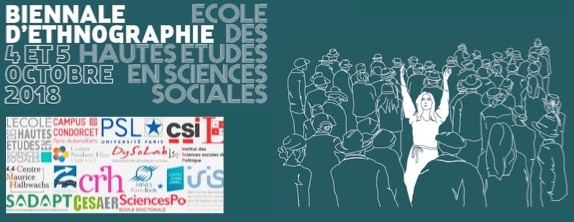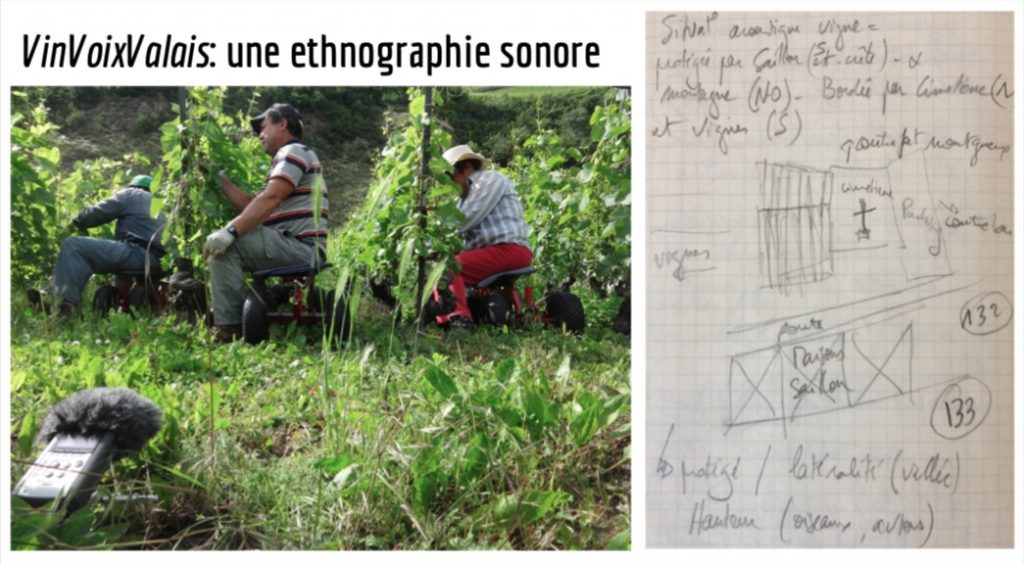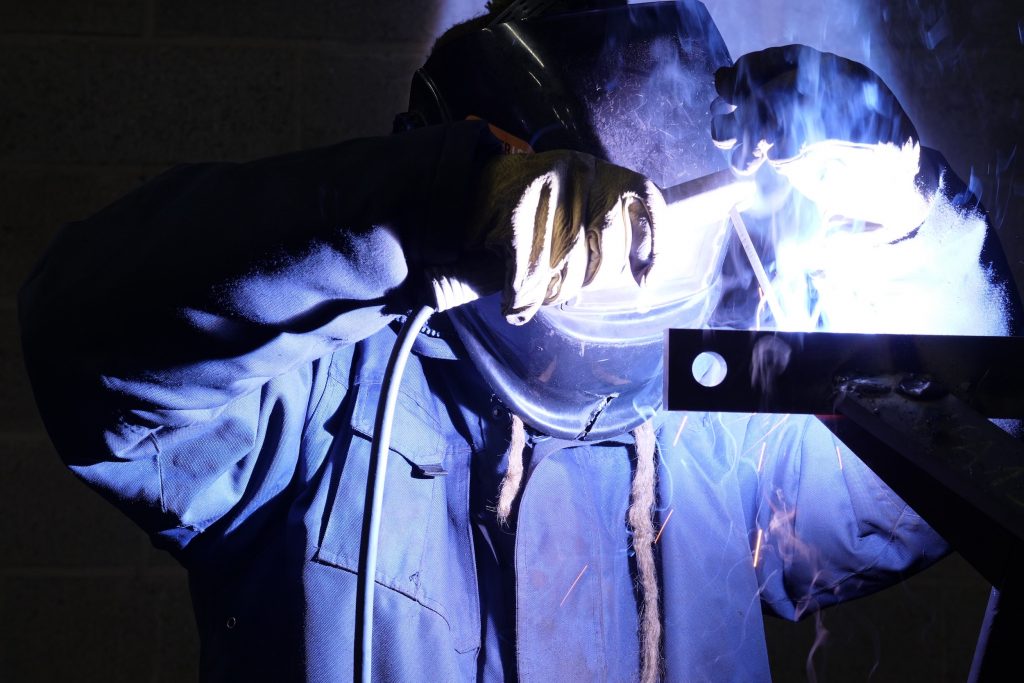Mathieu Rajaoba et Sophie Tabouret, PhD Candidates at the CSI
The proliferation of agricultural innovations: a call to question how social sciences investigations are performed

Following the success of the three previous EHESS Annual Ethnography Meetings, the first Ethnography Biennial of the EHESS, which included twelve workshops and a conference, was held on October 4-5 2018. The principle of the event was to provide a space for reflection and visibility to the ethnographic inquiries led by doctoral students and young researchers working from a variety of social science disciplines. The workshops were centered either on objects of study that require specific inquiry strategies (NGOs, environment, professional mobility, justice, asylum seekers, agriculture, social relations), or on modes of involvement into research fields that question the nature of the data collected (gossip, senses, body techniques, affects).
The workshop we organized was titled « Commitments, debates, positionings: investigating alongside the actors. The case of agricultural innovations ».
The initial idea was to discuss research on sociotechnical innovations in agriculture. Sophie’s research focuses on varietal innovations in viticulturethat bear the promise of a pesticide-free viticulture. Mathieu’s doctoral research explores the emergence of digital technologies in agriculture in France. Our intent was to question the proliferation of innovations in agriculture – whether digital (Bronson et Knezevic 2016), genetic (Bonneuil et Thomas 2009), organizational (Le Velly, Dufeu et Le Grel 2016) or innovations related to cultural techniques (Goulet et Vinck 2012) – and how social science investigations deal with this proliferation. Being the witnesses of major stakes, these objects of study act as privileged mediators in the approach of issues relating tothe relationships to the living beings and environments, and are confronting us to issues relating to climate change, as well as to health and environmental risks. This aim of the workshop was to discuss the requirements and the consequences of an ethnographical inquiry put to the test of these objects of study. Two movements in particular caught out attention.

The first one arises in a context where the knowledge production regimes in agriculture are called into question (Bonneuil et al. 2016). The transition from a centralized innovation regime to a regime of distributed innovation can be observed, and is even advocated, against of the growing influence of an intensive innovation regime (Callon 2012; Joly et al. 2015). Specifically, there has been a proliferation of so-called “participative research” where the researchers finds themselves “embedded” (Aguiton 2018; Fallon & Thoreau 2016). Working alongside so-called “hard” science researchers, they are often commissioned for a specific project, ranging from providing support for the acceptability of an innovation to organizing workshops with the stakeholders. The fact that researchers are often commissioned (this was the case of the work discussed during the workshop) gives them privileged access to the field.
The second movement combines the achievements of Science and Technology Studies (STS) that take into account the agency of non-human entities (Houdart & Thiery 2011) and the increasing interest of thinkers in the field of care for agricultural issues (Puig de la Bellacasa 2015; Krzywoszynska 2015; Porcher, 2015). Maria Puig de la Bellacasa draws on the observation of the different ontologies of soil and the need expressed by a part of soil scientists to call into question its intimate relationship to productivism. This includes taking soil into account as a living community that hosts a multitude of beings who participate in its renewal, in a temporality different from that of agricultural production. She thus proposes re-thinking the place of soil in agriculture. Jocelyne Porcher suggests paying a similar attention to the reincorporation of domestic animals into the analyses of human societies. She thus refuses the artificial divide that tends to take them into account in the natural sciences alone (Porcher, 2015). Following the actors who emphasize the multitude of beings who populate our agricultural lands and interact in the sociotechnical environment of innovations in agriculture seemed to us a motivating line of thought.
Thus the central challenge of the workshop was to be alert to how theses two movements can influence the practice of the ethnographer, and how our ways of observing, describing and writing are recomposed. What stood out from the workshop, and will be reported on here, is the convergence of the two movements outlined above. If the necessity to take account of a multitude of beings prevailed for the participants, this was implemented within the collectives identified and according to participative survey formats.
Three original commitment devices on agricultural fields
Three presentations were followed by the precious contribution of Morgan Meyer, a research director at the CNRS and researcher at the CSI[1], who was present as a discussant.
Through the experience of making several films about “L’Atelier Paysan” – a self-construction agricultural equipment cooperative – Jérémie Grojnowski, a PhD student in visual and filmic anthropology at Paris Nanterre University, proposed to question the possibilities offered by films, in particular the archiving of the collective’s activities. The film also allows to reveal a sensitive relationship to matter, or offers the possibility to draw portraits considered as biographical fragments of innovation actors.
Then, Emiliano Battistini, PhD student in the department Culture and Society at the University of Palermo, and Nathan Belval, PhD student at LAB’URBA at the University Paris-Est, took us to the Valais to discover sounds that traverse wine production. The sound ecology questions the relationship between humans and the sounds around them. While the collection of sounds may have been surprising for some of the persons surveyed, it also highlighted the attention paid to sounds during the wine processing: this winegrower, for instance, who inquires about the good fermentation of the wine by sticking his ear on the wine barrel, or this other winegrower who listens to the noise of the shears in order to follow the workers’ pace.
Lucile Garçon, who is currently a post-doctoral fellow at AGIR (INRA), presented a text co-authored with Nathalie Couix and Laurent Hazard about the early stages of on on-going research on the assessment of the selection practices of the producers involved in the selection of maize populations. While the experiments planned at the beginning of the project aim to build or fill databases, Lucile is interested in the margins of these databases, in what cannot be entered there. To do so, she has developed an ethnographic approach that uses the film both as an element of investigation and a space of exchange with the people surveyed during joint viewings.

We have thus welcomed three ambitious presentations that, while following the lines of discussion tracks proposed in the call for papers, have significantly extended and enriched them. Two of them have explicitly tackled objects that could be described as innovations: seed populations in Lucile Garçon‘s presentation and self-construction in Jérémie Grojnowski‘s. However, the focus of these presentations was not on the survey approach to varietal innovations. Rather, the agricultural activities and the sensitivity developed with living things and matter by the farmers invite the researcher to renew his investigative approaches. As such, the three presentations meet in the highlighting of senses within their respective research fields. Whether sounds or texture, the ethnographic work focuses on the study of senses that can be shared thanks to audiovisual tools.
In our view, these presentations mainly show three original commitment devices for engaging on agricultural fields. These devices are most characterized by the use made of audiovisual media, but mainly because they give an opportunity to problematize the agricultural experience in its multiplicity while requiring that we redefine our ethnographic interferences that are the consequences of our arrival in the field.
Making visible the multiplicity of knowledge encountered in the agricultural worlds
The four speakers have brought a contribution to the first strong thematic we wanted to discuss during the workshop: making the multiplicity of knowledge arising in the agricultural worlds visible.
The surveys presented are characterized by an intent to engage in an in-depth review of agricultural practices with the people surveyed, and this becomes possible in a very fine and detailed way using audiovisual media. In such investigative schemes, the investigators are in the position of mobilizing a variety of subject-specific and disciplinary knowledge. References to the science of sound, museography, visual anthropology or even ergonomics are thus at the heart of the fieldwork reports.
These multidisciplinary commitments contribute to a fruitful blurring of the partition between theinvestigators and the people surveyed, but also between professional researchers and the people concerned, in the production of new knowledge. In the three presentations, we indeed dive into the cloud of what it means to document the experience. This involves putting to the test the possibilities opened by sound, image or film in order to provide an alternate description of agriculture.
Relocating the agricultural issues through ethnography
The texts discussed thus undeniably expand the possible grips to be used for the formulation of problem-specific questions about agriculture. Indeed, the investigations conducted make visible the way in which knowledge is mobilized, but also the way in which the ethnographers can contribute to the shaping of these spaces of visibility. And this was a central point of the call for papers: we wanted to stimulate a broad reflection on survey formats.
What is immediately striking in the presentations is the place of the commission in these researches. It contributes to the shaping of the ethnographers’ point of view, whether they are embarked in the curation and the marketing of an exhibition or have to create a link between the actors of self-construction through the production of a collective narrative or have to imagine new ways of working on varietal selection based on the sharing of experience though an ergonomic approach.

Schematically, we can retain three main contributions to the issue of the survey formats.
First, the three presentations highlight the conditions for the researcher’s participation in the creation of political collectives. More specifically, in these agricultural worlds the researchers set up a dialogue with the farmers, peasants and wine growers. Through the feedback on the successive steps and the back and forth of the inquiry, they show how ethnography allows to relocate agricultural stakes.
Second, this relocation involves raising awareness about the tensions experienced in the field, further increased by the importance of senses, of noises. Each of the presentations has demonstrated impressive attention to the movements surrounding the production of wine, to the becoming of a cooperative and to the concomitant instability of the seeds and the ways of working with them. To use a striking expression of Jérémie Grojnowski, in each case, the local is indeed transfigured. It is never reduced, but rather redistributed around issues the actors are concerned about and which are part of a territory.
Finally, all three presentations have provided insights into what is sometimes referred to as “collaborative research”. They have explicitly demonstrated that with such committed devices as self-confrontation interviews, the curation of an exhibition or the archiving of a political movement, it becomes even more imperative to be creative with the mediations we introduce to investigate with the actors.
About the recomposition work of the field and its co-construction
The discussion led by Morgan Meyer highlighted the interest of putting on the table the importance and the need to accept the hesitations and the surprises encountered on the field. The positioning of the researcher between distance and commitment, the format of survey results or the use of audiovisual media are all topics that were addressed and discussed with the participation of the audience. We have learned that a “strange” field requires new thematization. Describing in order to clarify what we are doing makes it possible to recompose our field. In other words, inquiring alongside actors involves “daring to reject the opposition between an ‘analytical framework’ and its object and forget the injunction made to every apprentice sociologist to ‘construct his object’ and rather learn to live up to the experiences they are interested in” (Hennion 2015). The co-construction of the field alongside the actors we meet hence requires particular attention. It is interesting to delineate what we co-construct, what we share, and what co-producing means: more than sharing, a reciprocal appropriation. Finally, the survey devices provide an experience to be made that is not as simple as a partition between a protocol-based evaluation and (idealized) representations of farming knowledge.
Agricultural fields and the call to be sensitive to innovation
We had launched a call for papers about innovations as a means to address social sciences issues in agricultural fields. This call to be sensitive to innovation resonates with concerns related to our respective doctoral theses about the ecologization of viticulture for Sophie and the reconfigurations triggered by the challenge of agricultural data for Mathieu. These innovations did not come out of this call as a main tread of reflection on the modalities of the ethnographic survey. In relation to the strings gathered during the workshop, these innovations appear as catches of varying importance, which also vary over the investigation process and according to the survey. Faced with the impossibility to collect surveys “on” innovation in agriculture, we then felt very strongly the call from the agricultural fields to realign and constantly renew the mediations and the interferences of the survey at the risk of losing the opportunities offered by the ethnographical device.
References
Aguiton Angeli Sara. 2018. La Démocratie des chimères. Gouverner la biologie synthétique. Éditions Le Bord de l’Eau.
Bonneuil Christophe, Demeulenaere Elise, Thomas Frédéric, Joly Pierre-Benoît, Allaire Gilles & Goldringer Isabelle. 2006. « Innover autrement ? La recherche face à l’avènement d’un nouveau régime de production et de régulation des savoirs en génétique végétale ». Dossier de l’environnement de l’INRA, n° 30, p. 24-52.
Bonneuil Christophe & Thomas Frédéric. 2009. Gènes, pouvoirs et profits: Recherche publique et régimes de production des savoirs de Mendel aux OGM. Editions Quae.
Bronson Kelly & Knezevic Irena. 2016. « Big Data in Food and Agriculture ». Big Data & Society, January-June: 1–5.
Callon Michel, Rip Arie & Joly Pierre-Benoit. 2015. “Réinventer l’innovation?” innovatiO, Numéro 1 : Innovation? une problématique pluridisciplinaire. [En ligne]
Callon Michel. 2012. “Quel rôle pour les sciences sociales face à l’emprise grandissante du régime de l’innovation intensive ?” Cahiers de recherche sociologique, no. 53: 121–65. [En ligne]
Fallon Catherine & Thoreau François. 2016. Rejouer les partitions disciplinaires : l’interdisciplinarité comme épreuve dans le cas de la génomique. Editions des archives contemporaines.
Goulet Frédéric & Vinck Dominique. 2012. « L’innovation par retrait. Contribution à une sociologie du détachement”. Revue française de sociologie 53 (2): 195‑224.
Hennion Antoine. 2015. “Enquêter sur nos attachements. Comment hériter de William James ?” SociologieS.
Krzywoszynska Anna. (2015) What farmers know: experiential knowledge and care in vine growing, Sociologia Ruralis.
Le Velly Ronan, Dufeu Ivan & Le Grel Laurent. 2016. « Les systèmes alimentaires alternatifs peuvent-ils se développer commercialement sans perdre leur âme ? Analyse de trois agencements marchands.” ». Économie rurale, no 356: Pp. 31-45.
Porcher Jocelyne. 2015. “Le Travail Des Animaux d’élevage: Un Partenariat Invisible?” Le Courrier de l’environnement de l’INRA 65 (65): 29–36.
Puig de la Bellacasa Maria. 2015. “Making Time for Soil: Technoscientific Futurity and the Pace of Care.” Social Studies of Science 45 (5): 691–716.
[1] For an overview of Morgan Meyer’s research interests see Producing knowledge and technologies at the boundaries of scientific institutions published on the CSI’s website.

